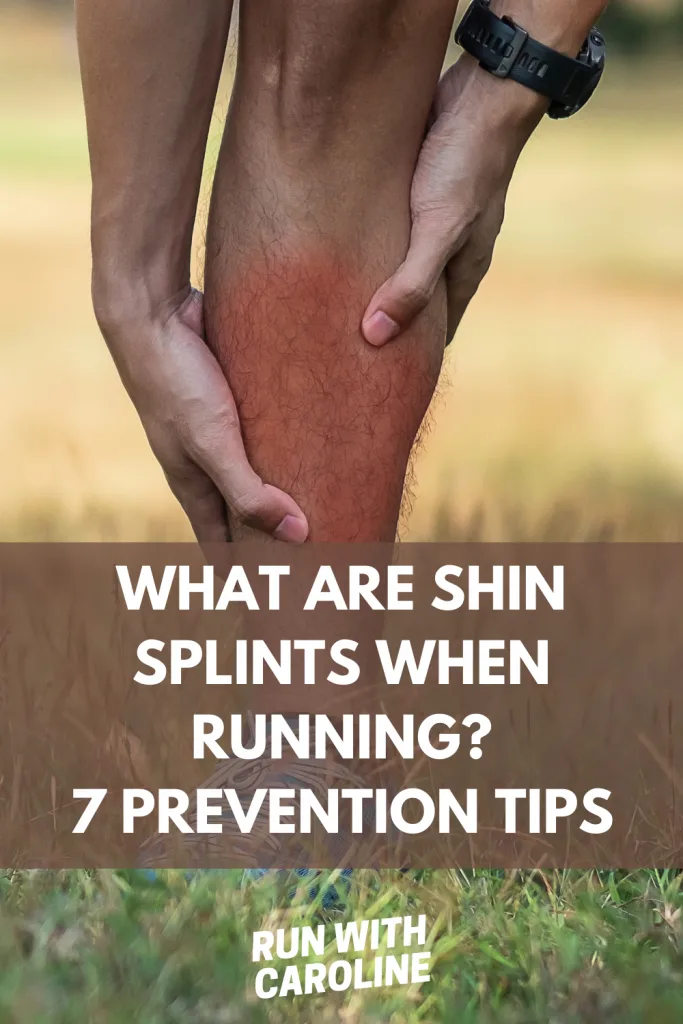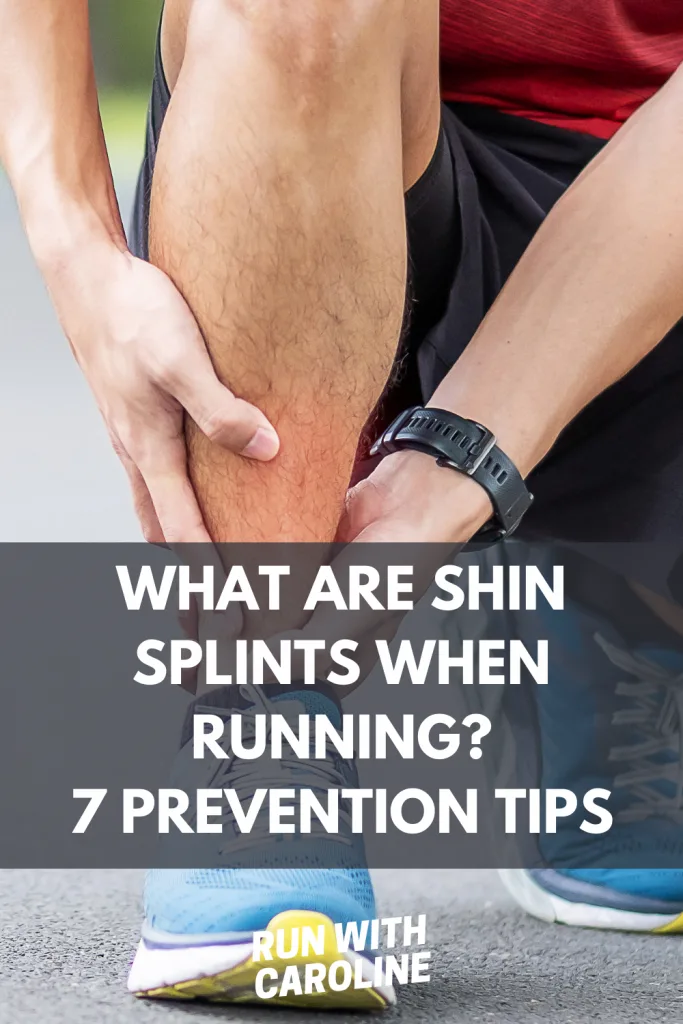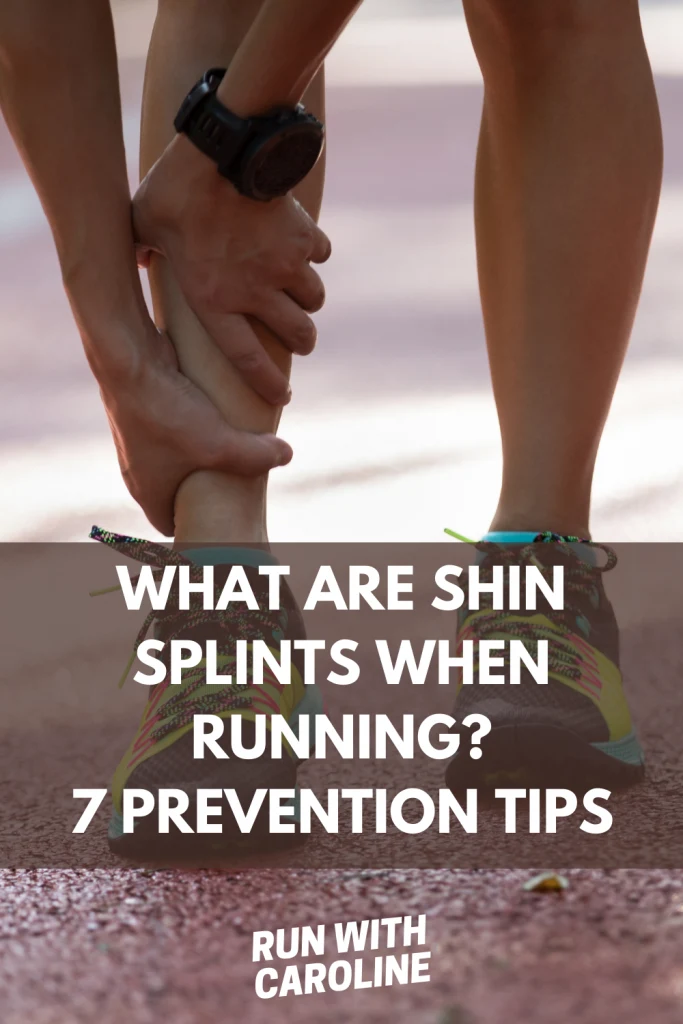Shin splints when running are the bane of many runners.
They aren’t normally serious, but they can be a very annoying pain and if left untreated, can get slowly worse.
They’re common in people who do a lot of running or other activities that involve repeatedly putting on weight on the legs, such as tennis or basketball.
If you struggle with shin splints when running, this guide will offer some tips to help prevent them in the future.
In this guide we’ll explore:
- What are shin splints?
- What are the symptoms of shin splints?
- What causes shin splints when running?
- Who is at risk of shin splints when running?
- How to treat shin splints
- When can I start running again after shin splints?
- How to prevent shin splints when running
Ready?
Let’s go!

What are shin splints?
Shin splints (otherwise known as medial tibial stress syndrome) is the name for the pain that occurs in the shins or at the front of your lower legs after running or exercise.
Repetitive stress on the shinbone and the connective tissues that attach your muscles to the bone causes pain and inflammation.
The pain tends to begin soon after running or starting exercise.
Whilst the pain may be dull and achy to begin with, after time can become increasingly sharp or severe, eventually stopping you from exercising.
It’s important to rest as soon as you start to feel pain because if you try and exercise through the pain, it could eventually become chronic and continue even when you’re resting.
Related: Heel pain after running: Causes + 8 ways to prevent it
What are the symptoms of shin splints?
If you think you have shin splints there are few symptoms to look out for.
Here are the signs and symptoms of shin splints when running:
- Pain in the shin bones which runs down the front of your lower legs
- Swelling and inflammation around the shin bones
- Mild swelling in your lower leg
- Tenderness and soreness or pain along the inner side of your shin bone
If you experience any of these symptoms, it’s advisable to seek advice from your GP as it could be an underlying sign of a stress fracture.
Related: IT band syndrome: Signs, symptoms and treatment

What causes shin splints when running?
A 2013 study found that the following factors are all associated with an increased risk of developing shin splints:
- Female gender
- Previous history of shin splints
- Fewer years of running experience
- Increased body mass index
- Increased external rotation hip range of motion in males
It’s important to note that no one knows the exact cause of shin splints, but there are several things that are thought to cause them.
Here are some common causes of shin splints:
- A sudden change in activity levels
- Running on hard or uneven surfaces
- Tight calf muscles
- Weak ankles
- Tight Achilles tendon
- Flat feet
- Heel footstrike
- Running in worn out running shoes
A sudden change in activity levels
If you take sudden leaps in your training (e.g. increased distance, frequency or intensity) then this can cause the pain or make the pain worse.
If you’re a new runner, for example, and start a beginner running programme, you are at greater risk of developing shin splints.
Running on hard or uneven surfaces
If you run on uneven terrain such as a sloped surface or hard surfaces like concrete then you are more at risk of developing shin splints.
Tight calf muscles
Stretching out the calf muscle and surrounding muscles helps to relieve shin splint pain.
Weak ankles
Weak muscles around your legs and ankles can cause shin splints.
If the tibialis posterior muscle in the leg is weak, you will lose strength when running, and this often causes shin splint pain.
Tight Achilles tendon
If your Achilles tendon is tight, it is harder for the anterior extensor muscles in the foot to extend backwards (dorsiflexion), thus causing anterior shin splints.
In addition, if the Achilles tendon is tight, the foot can pronate (flatten) and the arch in the foot collapses as a result, putting strain on the functions of the foot.
Flat feet
Flat feet (pronation) cause the muscles around the leg to work harder and longer to resist the excessive amount of movement at heel strike, resulting in shin splints.
Heel footstrike
If you have a heavy reliance on heel striking, especially if you’re a new runner, this develops shin muscle overuse pain.
Running in worn out running shoes
Running in worn out running shoes that do not support or stabilise your feet can cause shin splints.
Related: Side stitch when running: Causes + 7 prevention tips
Who is at risk of developing shin splints when running?
You are at risk of developing shin splints when running if you:
- Take sudden leaps in your training (e.g. increased intensity or distance)
- Are a new/beginner runner
- Are overweight
- Run in worn out running shoes
- Run on hard or uneven surfaces
- Have tight calf muscles
- Have weak ankles
- Have flat feet or high arches
- Have a tight Achilles tendon
- Run using a heel footstrike
Related: Hip pain after running: 8 causes + how to prevent it

How to treat shin splints
Shin splints can usually be treated at home. Here are the steps you need to take to treat shin splints:
#1 Rest
The first step is to rest. Stop running for at least two to three weeks then gradually start to reintroduce running to your normal schedule.
#2 Apply ice
The next step is to hold an ice pack against your shins. A bag of frozen peas wrapped in a tea towel works well too.
Hold the ice pack against your shins for around 10 minutes every few hours for the first few days. This will help with the swelling and inflammation.
#3 Take pain medication
In terms of pain relief, over-the-counter painkillers such as paracetamol and ibuprofen can help to relieve the pain.
#4 Switch to low impact exercise
If you do not want to completely stop all forms of exercise during treatment, then switch to low impact activities like walking, cycling and swimming as long as you don’t experience any pain.
The key is to avoid repetitive exercise of your lower leg.
Yoga is also a good form of cross training for runners as it helps with flexibility – something that runners don’t work on enough!
It also doesn’t put too much pressure on your shins.
#5 See a physical therapist
If the pain does not subside, work with a physical therapist.
A physical therapist will help alleviate the pain and will teach you exercises and stretches to strengthen your leg muscles.
Related: Lower back pain after running: Causes + 7 ways to prevent it
When can I start running again after shin splints?
You can start returning to running once the pain has gone and the swelling and inflammation has gone down.
Be sure not to increase your activity levels too soon when you return to running.
If in doubt, follow a beginner training plan or a training plan suitable for someone returning from injury.
The best judge of all is you – your body!
If it just doesn’t feel right when you’re running, stop, slow down and take it step by step.
You don’t want to risk the pain coming back again, so go easy on yourself!
Related: Knee pain after running: Causes + 10 prevention tips

How to prevent shin splints when running
There are a number of ways to help prevent shin splints.
#1 Wear running shoes that cushion and support your feet
Visit your local specialist running shoe store and ask for advice on the best shoes for your feet.
They will ask you questions to help determine the best type of shoe for you.
They may also ask you to do a gait analysis which is basically a way of helping you to determine which running shoe is right for you.
#2 Run on soft, grassy surfaces where possible
If you’re used to running on hard, concrete like surfaces, try and run on softer surfaces like playing fields where possible.
#3 Follow a training plan suitable for your experience and fitness levels
If you’re a beginner runner, the Couch to 5k training plan is a great way to start.
You can take it in your stride and re do a week if necessary.
#4 Cross train
Activities like cycling, swimming and yoga are all great cross training activities for runners.
These are all low impact and push your body in different ways.
#5 Improve your strength and flexibility
Yoga is a great option for improving flexibility, whilst strength training, such as bodyweight or free weight exercises, can go a long way to make your muscles and joints stronger.
Read my guide on strength training for runners for more information.
#6 Warm up before each run
A proper warm up helps to prepare your body for the run ahead by mobilising your joints and muscles.
It’s also a great way to get you in the right frame of mind for your run.
The warm up should raise your heart rate but not leave you exhausted before the run.
It’s also a good idea to focus on dynamic stretches that stretch out your calves and the front of your legs.
#7 Speak to a healthcare professional or a foot specialist
If you’re really struggling with pain, speak with a healthcare professional or a local foot specialist (podiatrist).
They can help to recommend treatment plans for you, including supportive insoles in your shoes.
- 5 things I wish I’d known before returning to running - March 3, 2024
- Running 20 minutes a day: Benefits + how to start - January 27, 2024
- How to run your first 2 hour half marathon - January 16, 2024
